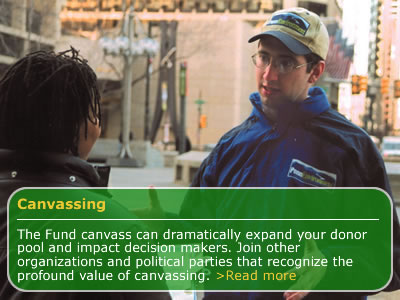In order to raise funds, many large groups use canvassers who stand in the street, in shopping malls, or go door to door, or sit on telephones, asking people to join the groups and pay a membership fee. Canvassers usually keep a percentage of the fees they collect as payment for their work. Canvassing has been "described as pyramid selling environmentalism".
 Direct mail is also used to raise funds and increase membership/subscribers. According to Mark Dowie:
Direct mail is also used to raise funds and increase membership/subscribers. According to Mark Dowie:
The problem is that when direct mail becomes the preferred method of building membership, large national organizations all too often come to regard it as the only form of political organizing needed. The results of direct mail campaigns then become tacit opinion polls that organisations rely on to guide policy and programs.
The same can be said of canvassing. However direct mail donors tend to be "a cautious and conservative group" who prefer lobbying and negotiaton to direct action and confrontation. In 1993, when Greenpeace leaders in the UK wanted to join the community campaign against a waste incinerator in East Liverpool, it was advised by its direct mail consultants that this would not appeal to direct mail donors, so it didn't go ahead.
Another form of fundraising used by some of the national environmental groups is telemarketing: "the New York boiler room of $6.00-an-hour telemarketers hustrling advance renewals or emergency funding—teenagers reading almost phonestically from index cards or a 'talk book' about some spurious crisis requiring your special attention.'"
 Greenpeace relies more on canvassing, perhaps because those approached this way are more amenable to Greenpeace style activism. Greenpeace Australia, introduced canvassing in 1989, when the new American executive director took over. Canvassers sold Greenpeace subscriptions for a 35% commission with payment "essentially subscription to the quarterly magazine" and various marketing publications. There are only 50 voting members of Greenpeace Australia.
Greenpeace relies more on canvassing, perhaps because those approached this way are more amenable to Greenpeace style activism. Greenpeace Australia, introduced canvassing in 1989, when the new American executive director took over. Canvassers sold Greenpeace subscriptions for a 35% commission with payment "essentially subscription to the quarterly magazine" and various marketing publications. There are only 50 voting members of Greenpeace Australia.
Hazy Notion says of Greenpeace:
As a light green organisation integrated into the new environment industry one can see them as packagers and marketers of a new product; environmental theatre. This product is sold by subscription to suburban householders who use it as a palliative for enviro-anxiety. Regular doses appear to allow suburbanites to continue normal producer/consumer lifestyles.
In 1994 the Greenpeace Australia canvassing division, which was costing $1.9 million and achieving declining subscriptions, was terminated. It was superceded by a 'Friends of the Rainbow Warrior Monthly Giving Program' which deducted $10 each month from contributers bank accounts.
Greenpeace has since reinstated canvassing as a fundraising strategy (see this advert and video). It has 'partnered' with The Fundraising People, who also raise money for the Australian Conservation Foundation (ACF), the RSPCA and other charities through street canvassing. Greenpeace also uses telemarketing for fundraising.
In 2012 Greenpeace spent $6 million on fundraising, compared with $10 million spent on campaigns, to raise $16 million, $12 million of which came from automatic deductions from donor accounts.
 The members of environmental groups enrolled through canvassing, direct mail or telemarketing, are little more than subscribers who pay their money and do not actively participate in the group. They may receive a regular newsletter or magazine and email correspondence but they generally do not take part in actions, do not meet with each other, and do not have a vote in how the group is run. Their relationship with the group is impersonal and unengaged and they are more like consumers than activists. They often only subscribe for one year so there is a constant need to keep up the mail or canvassing year after year.
The members of environmental groups enrolled through canvassing, direct mail or telemarketing, are little more than subscribers who pay their money and do not actively participate in the group. They may receive a regular newsletter or magazine and email correspondence but they generally do not take part in actions, do not meet with each other, and do not have a vote in how the group is run. Their relationship with the group is impersonal and unengaged and they are more like consumers than activists. They often only subscribe for one year so there is a constant need to keep up the mail or canvassing year after year.
For decades, environmentalism has been suffering the ill effects of atrophying from a social movement into a line-up of mailing-list-driven interest groups...
In a society that needs active citizens, every person that national environmental groups ask for money is one more person who hasn't been asked to become active in a more meaningful way. Instead, they receive the contradictory messages that the environment is in great danger, that we must act, and that the best way to avert this catastrophe is to write a $15 check — and maybe change some light bulbs.
In order to encourage public donations and subscriptions there is a tendency for environmental groups that depend on them, to choose campaigns and issues that are fashionable at the time, and appeal to public emotion, rather than those that are most important to environmental goals.
The membership of local grassroots groups and some larger groups like Friends of the Earth, tend to be more active, attending meetings, interacting with other group members, discussing issues and tactics. The aim of such groups is to persuade people to their point of view and mobilise them to achieve change.
Larger groups engaging in canvassing are increasingly measuring their success in terms of the money they raise and the numbers of members they can claim. They employ professional lobbyists and advocates to negotiate change with those in power rather than "rallying the troops". Those employed by these groups have little relationship with their membership base who merely supply funds and legitimacy.
Dana Fisher, in her book, Activism, Inc, wrote:
Instead of educating the public about ways to pressure their political representatives personally, or actually cleaning up the polluted river—both of which are difficult, long-term projects—the organization identified how much money and how many names it needed to work the political system and then paid the canvassers to achieve these instrumental goals.
In the US, canvassers for large environmental groups tend to be provided by outsourced organisations, that employ "idealistic young people who are looking for opportunities in progressive politics during their summer vacations from college and after graduation". These young people have no say in the direction of the group's they are 'campaigning' for, they just do what they are told, believing they are working for the greater good.
In the late 1990s, the grassroots campaigns for left-leaning organizations [in the US] became consolidated, with many progressive groups hiring intermediary organizations to run their local campaigns by canvassing... By hiring political professionals and national canvassing firms, campaigns fail to become embedded in the local institutions and grassroots networks of civil society...
Similarly, direct mail consultants are used by many environmental groups. Direct mail "requires a professional well paid staff to determine what will and will not work. They must be backed up by pollsters, list managers, consultants, and at least one contracted fulfillment service". Consultants advise on what environmental campaigns are likely to be most successful with donors and that it is important to be seen to be winning, even if that requires compromise.
Canvassing organisations raise money and increase membership bases for environmental groups, consumer groups, human rights groups,  child welfare groups and political parties (ie the Democrat Party), at a national and state level. For example the Fund for the Public Interest, one of the largest canvassing organisations in the US, has done canvassing for dozens of organisations including Greenpeace USA, the Sierra Club, Natural Resources Defense Council (NRDC) and many other environmental groups as well as Save the Children and the Human Rights Campaign.
child welfare groups and political parties (ie the Democrat Party), at a national and state level. For example the Fund for the Public Interest, one of the largest canvassing organisations in the US, has done canvassing for dozens of organisations including Greenpeace USA, the Sierra Club, Natural Resources Defense Council (NRDC) and many other environmental groups as well as Save the Children and the Human Rights Campaign.
Canvassers do not march in the streets or take part in rallies, at least not on the Project's time; to be a canvasser is to be a foot soldier for the campaign. Beyond raising money, canvassers are expected to write letters to politicians on selected issues and submit opinion pieces to local newspapers—in both cases, the [Fund for the Public Interest] provides form letters the canvasser may use or customize.
People employed by canvassing organisations tend to have little knowledge of the issues that each group is engaged with. They are given a short standardized training in canvassing and a set script for each group they are canvassing for. It is hard work and only some sorts of people are suited to it: "it assumes that these idealistic young people have nothing beyond their time and their bodies to add to progressive campaigns". Most don't last very long at it.
The many who do not fit the model include those who are not comfortable speaking to strangers and selling political campaigns as if they were encyclopedias. A number of canvassers who decided to leave were more interested in asking questions and deliberating about the best solutions to political problems than reciting a script; they wanted to be involved in the hard work of democracy... too many get turned off or spit out by a standardized system that measures political change and success in terms of money and nominal membership over progress and movement toward political goals.
Nevertheless, canvassing is one of the few entry points into a career with an environmental group: "the canvass is the gatekeeper to
jobs in progressive politics". The pathway from volunteer activist in a local group to paid professional has mostly disapeared in the US.